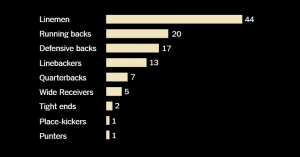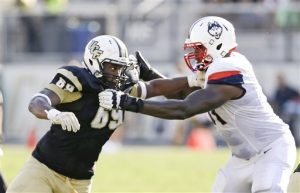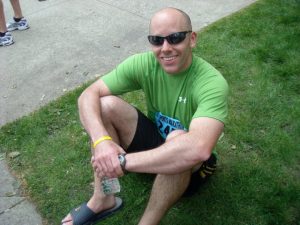Studies have shown that the average length of NFL careers has shortened over time as opposed to extending
By Hector Cruz-Rodriguez
Journalism 2001
May 2021
Due to advancements in exercise science and a greater awareness of injury, American football players’ careers have been found to be shorter on average in the last 20 years.

With players such as Tom Brady and Drew Brees continuing their stellar careers into their 40s, one would naturally come to the conclusion that NFL-level athletes are enjoying longer careers.
However, due to a multitude of advances and changes, studies have shown that players are often retiring earlier on average.
Since 2008, the average career length of a quarterback has dropped from six years to just over three years, according to a study done by the Wall Street Journal in 2016.
According to chron.com’s data, the average career length, as of the 2018–19 season, was around two and a half years.
A principal factor in deciding to “call it quits” early has been the ongoing studies and controversies surrounding concussions, and the protocols the league has recently put in place
In 1994, the same year the league formally began investigating the effects of concussions, the National Institute for Occupational Safety and Health reported a significant increase in the percentage of neurological disorders among ex-NFL players.
One common neurological disease among players is chronic traumatic encephalopathy, or CTE. This disease has been linked to repeated blows to the head, which is extremely common in football.
CTE has also been found to get worse over time, and often leads to dementia.
Even with the building controversy, the NFL has gone to great lengths to prove that the effects of CTE aren’t as prevalent, or dangerous, as many studies have shown it to be.
While they launched the “Play Smart. Play Safe.” initiative in 2016, the league also promised to become one of the biggest backers for concussion research, with a reported $100 million being reserved for studies.
In 2017, the league was found to have only funded one study, conducted by an Australian researcher who had gone on record several times before then, describing CTE as “carry-on and hoo-hah.” That same year, the New York Times reported that a neuropathologist examined 111 brains of deceased NFL players, and only one was found to not have CTE.

CTE was found to be most common among linemen, while place-kickers and punters only had one case each.
Special teams positions such as kickers and punters, on average, have substantially less time on the field as compared to the offensive or defensive line, which would explain the difference in the amount of cases between more contact-heavy positions.
In a telephone interview, Carlos Nava, ESPN Deportes reporter, discussed the ongoing issues regarding the NFL and concussions in their former players.
“You look at a player such as Junior Seau, where his issues went unnoticed due to the ‘old school’ mentality, and he ended up doing what he did because of CTE.”

Nava then went on to discuss the advances in technology, both on and off the field, to take better care of the players.
“These players now have a better understanding of the risks, and as soon as they feel that something’s off, they can be taken into a tent and have initial results from a test in minutes. They know right away if they need to be taken out.”
However, the “tough” mentality of a football player is still very much present, said Nava.
“I wouldn’t say the mentality is being phased out, but players are certainly more aware of what can happen. The big problem is that, unlike other sports, their contracts aren’t guaranteed. They’re constantly fighting for top spots, and so the will to stay on the team will often overrule any other feeling.”
The unfortunate truth for a vast majority of NFL players is that many face financial hardship as little as two years after stepping off the gridiron.
In comparison to other major sports leagues such as the NBA and MLB, NFL contracts do not have guaranteed money, so the amount of money they make depends on whether or not they play, and play well.
Richard Levy, former offensive tackle for the New York Giants and San Francisco 49ers, talked in a phone interview about going through his years in both professional and college football, and his experience with having to

“relearn” how to tackle.
“With my position, there were meetings about improper ways of leading with your helmet, tackling high, headbutting instead of tackling, form tackling, stuff like that.”
Besides the team resources and doctors, Levy said many players often hire other personal trainers in order to maintain shape through the offseason, even with no restrictions in place regarding using team doctors during this time.
“If you wanted extra care, a lot of it was there, free of charge. Acupuncture, cupping, they had these things available to you, but if you wanted to get more assistance, you were more than welcome to.”
James Morais, recent Berlin High School graduate and former defensive tackle for the BHS Redcoats, spoke in a phone interview about the more recent strategies for teaching new players on how to tackle properly.
“Some kids already had some experience coming from middle school, like me, but a lot of them had never even picked up a football, or taken a tackle, in their lives up to that point… we had to make sure they weren’t gonna get seriously hurt. We had a lot of training in the beginning that revolved around making sure your shoulder was the first thing to make contact, not the top of your head.”
Morais went on to say that the biggest thing that the coaches wanted players to watch out for was helmet-to-helmet contact.
“Not only was it essential to watch out for because of the new rules, but we also wanted to make sure that players could actually walk off the field after a game, and be able to play again the next week,” Morais said.
“Even with these new helmets that my school invested in, getting a knock on your head was absolutely no joke.”
The other main factor in the average career shortening is the overall advancements that have been made in exercise science, and the overall awareness that more players have grown to have recently.
While the mentality in players may not be shifting, the training staff is quickly evolving as new techniques are discovered, in order to take better care of the players.
In a phone interview, Mike DeAngelo, manager of ESPN Wellness, talked about the advances in personal training in the NFL, and how outliers like Tom Brady have been able to stay in NFL quarterback shape at 43.
Brady’s exercise methods revolve around “pliable muscles,” as opposed to flexible muscles. Pliable muscles are soft in comparison to dense flexible muscles, and can be trained to absorb and disperse the force of a hit easier.

“His workout method, the TB12 method, is not anything new in the world of exercise science, but it is in the NFL.”
DeAngelo talked about how an old-school mentality was also plaguing strength and conditioning coaches.
“More and more teams are starting to adopt his (Brady’s) methods in their practices, and if their old-school ‘clean and jerk’ strength and conditioning coach opposes that, that coach is gone.”
This signifies that a change in mentality overall might be a reality sooner rather than later.
Interview with Mike DeAngelo, certified personal trainer, manager of ESPN Wellness, April 17
Interview with Carlos Nava, ESPN Deportes reporter, April 16
Interview with Richard Levy, former OT for UConn, NY Giants, 49ers, April 25
Interview with James Morais, former DT for Berlin High School Redcoats, April 27
Leave a Reply
You must be logged in to post a comment.